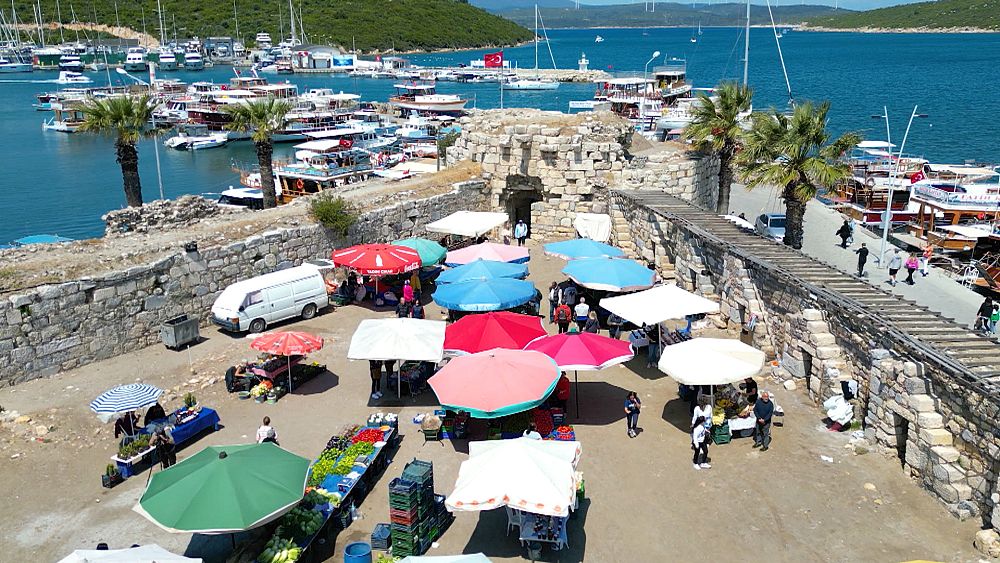Tasting the wine blessed by the Gods
The Agean Region of Türkiye is an area where you can experience immersion in nature, enjoy locally grown food and live in a sustainable way
Seferihisar, located about 50 kilometers from İzmir, is one of the most peaceful, historical and beautiful towns in the area. And it’s the first Turkish “Cittaslow”.
Cittaslow – an organization founded in Italy twenty-three years ago and inspired by the slow food movement – is a network of towns and villages that suit the slow pace of life and aims to prevent the impact of globalisation on an area’s local customs.
Seferihisar applied to the network in 2009, under the “supporting local producers” theme and finally became Türkiye’’s first slow city, by meeting all the 70 criteria. It has four bazaars set up weekly. One of them is the famous Sığacık Bazaar.
Here, whatever you buy is 100% local. Clean energy is prefered and street lamps are solar powered. During the years, Seferihisar has implemented many innovative programs as a slow city. And the drawer is still full of projects, as Candaş Balta, Cittaslow Seferihisar coordinator explains to us: “The most important project is actually an agricultural project. We have many – more than 200 different types of – local seeds, from tomatoes to peppers, etc. And because of this, we have established some seed banks and we gather all the local seeds in this bank and we share them with the people who live in Seferihisar right now. And we also share them in the international Cittaslow network”.
Without a doubt, one of the best and most ecological ways to visit the area is by bicycle. The Agean Region of Türkiye is a wonderland for cyclists. You can ride among its historical villages and towns, beautiful coastlines and countryside fields. Bikeways are created especially for cyclists. A section of the EuroVelo 8 – an almost 6,000-kilometre long route that covers 11 countries – passes by here. And it’s impossible to miss the multitude of olive trees, considered mythical and sacred in Türkiye, one of the main olive oil producers in the world.
The perfect region to grow olives
We are in the heart of Urla, just a few kilometers from Seferihisar, where the history of olive oil production is as old as civilisation itself. It’s said that its ancient city hosted the world’s oldest olive oil workshop… in the 6th century BC!
“Olive cultivation is not only important in terms of agriculture, it is also in our blood in a cultural and social sense, and it’s a sacred tree”, says Duygu Özerson Elakdar, owner at Hiç Olive Oil. “Olives are currently being cultivated in all regions of Türkiye. 96 varieties of olives are registered in our country. All of the unique aromas and taste pallets of these varieties constitute an extensively rich olive library”.
To help you to understand the importance of this product in Urla, local cuisine offers dishes called Zeytinyağlılar, which literally means “those made with olive oil”. “You can’t even think of cooking something without using olive oil. Especially if you’re talking about Urla. Everything in Urla is made with olive oil. This is indisputable”, says Duygu.
This is not the right season for the olives harvest, but there are other wild products worth gathering. Edible wild plants have traditionally been used in Urla cuisine for centuries, and they are very well integrated into the Urla cuisine culture.
In Urla, it’s common not only to use wild herbs leaves in the kitchen, but also their roots, flowers and seeds by approaching the situation with a futuristic gastronomic perspective.
Wine of the Gods
And there is another locally grown product that goes nicely with olive oil dishes. We’re talking about wine. Urla has a long history of wine producing, using regional grapes from Anatolia and the expertise passed down from generation to generation.
“Like all the areas in the world that are good for winemaking, Anatolia is considered a warm region. It’s a Mediterranean climate”, explains to us Bilge Benigisu Oğunlu, owner of the Urlice Wines. “We get a lot of sunny days, with no clouds and we have chalky soil that keeps the moisture in it, it preserves it and allows you to do dry farming. You don’t have to irrigate and the wines will be just vibrant even in September and November”.
The proximity to the sea plays an important role as well: “We are very close to the sea. We get winds from the north, cooling winds, and we also get winds from the south. So this is like a peninsula and that’s why it allows us to make wine in such a hot climate”, Bilge explains.
Award-winning wines made from grapes with a 6,000-year history can be found here. Grape harvesting is celebrated at the annual Urla Grape Harvest Festival, two days that feature grape treading, live performances and many other activities with participants coming from all across the globe.
And if you are not yet convinced of the regions wine credentials, just around the corner, you’ll find the ruins of the ancient city of Teos, home to the temple dedicated to Dionysus, the anceient Greek god of wine.



